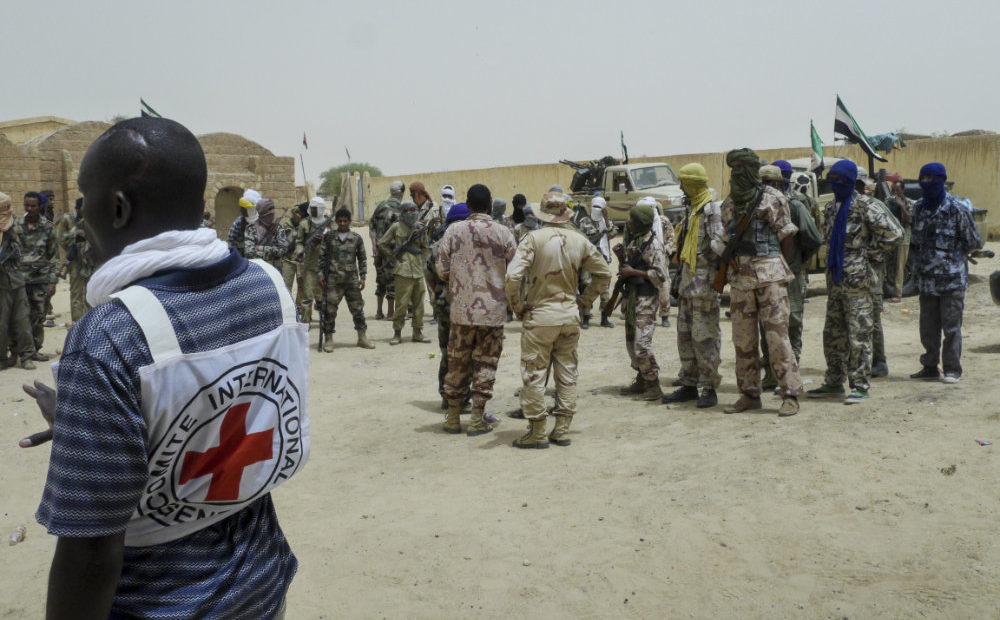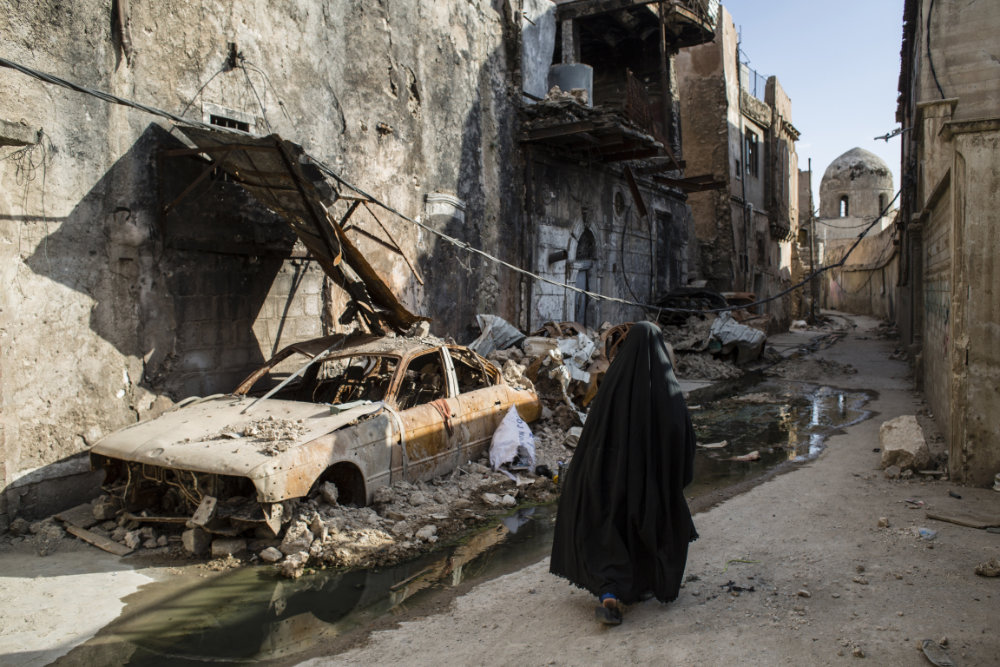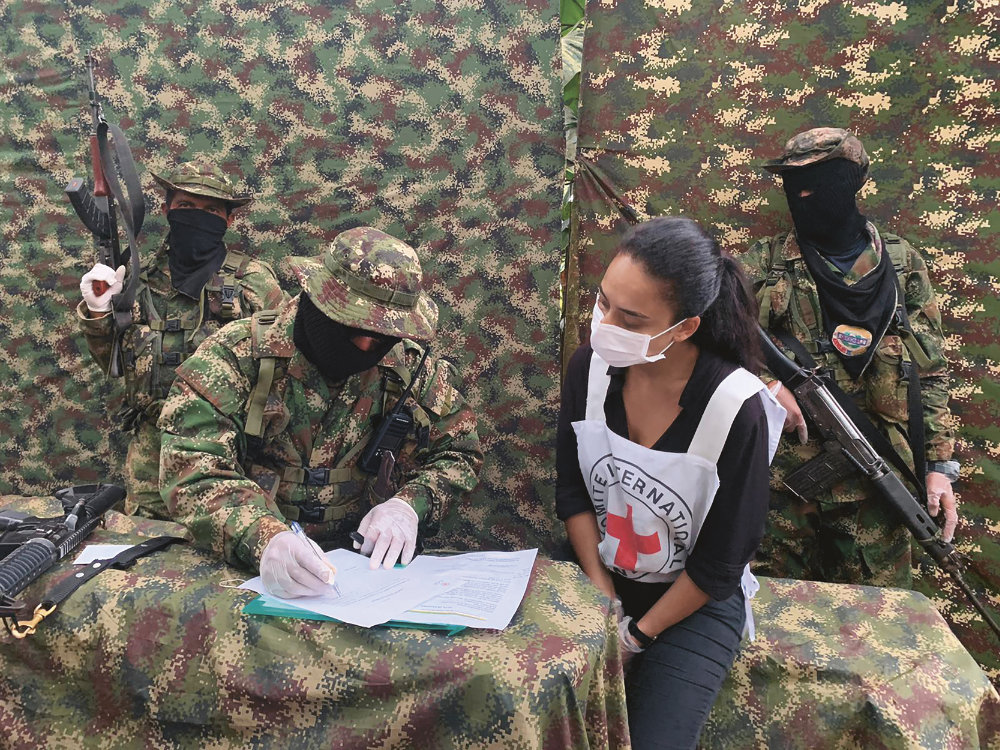In line with its mandate, the ICRC engages with all parties to an armed conflict, including non-state armed groups. The ICRC has a long history of confidential humanitarian engagement with armed groups to alleviate and prevent the suffering of persons living in areas controlled by these groups. However, this engagement has become increasingly complex. Accordingly, the ICRC undertakes an annual internal exercise to evaluate the status of its relationships with armed groups and to identify developments to strengthen its future engagement worldwide.
In this post, ICRC Adviser Matthew Bamber-Zryd discusses some of the key findings from this exercise. In 2024, the ICRC estimates that 210 million persons live in areas under the full or contested control of armed groups. There are more than 450 armed groups of humanitarian concern worldwide and the ICRC’s engagement with these groups remains stable. Despite the ICRC’s successful contact with 60% of armed groups worldwide, engagement with some groups remains challenging. These obstacles stem from a combination of state-imposed barriers, notably counter-terrorism legislation, and the precarious security environment prevailing in certain countries.
The ICRC engages with all parties to a conflict to access populations in need living in areas controlled by all parties, including non-state armed groups (NSAGs). Consequently, the ICRC has a longstanding practice of engaging in confidential discussions with armed groups which has resulted in the provision of life-saving aid and protective measures to individuals living in areas controlled by these groups. These actions include visiting detainees held by armed groups to monitor their well-being and facilitating the exchange of Red Cross messages, serving as a neutral intermediary in the release of prisoners, and delivering humanitarian aid to civilians in areas blockaded by armed groups, among other activities. Engaging with armed groups is thus a humanitarian imperative, essential for the ICRC to fulfil its humanitarian mission and carry out activities to alleviate and prevent the suffering of people living in areas controlled by armed groups.
Engagement with armed groups is crucial for several reasons. First, engagement is a precondition for the ICRC’s safe access to populations affected by armed conflict or other situations of violence. Secondly, engagement is vital to ensuring an armed group understands and accepts the ICRC as an independent, neutral and impartial humanitarian organization. Thirdly, it is essential for the promotion of international humanitarian law (IHL) and other relevant legal frameworks. This helps ensure compliance with the law and, consequently, prevents and alleviates the suffering of victims. Lastly, Article 3 of the 1949 Geneva Conventions explicitly mentions the ICRC as an organization that can offer its services to parties involved in non-international armed conflicts, including non-state armed groups.
The armed group landscape can evolve rapidly, with conflicts erupting and groups gaining or losing territory swiftly. Consequently, to effectively fulfil its humanitarian mission, the ICRC annually conducts an internal survey of armed groups through its delegations. This survey serves several purposes: it helps the ICRC gauge its current level of engagement with armed groups, spots trends in the behaviour of these groups, and evaluates opportunities for enhancing its engagement efforts.
This article presents key insights from the 2024 survey regarding the ICRC’s engagement with armed groups. It’s important to note that this data represents the priorities and concerns of the ICRC’s delegations. It therefore serves as an operational assessment rather than a scientific study. These figures may fluctuate each year due to external shifts related to armed conflicts, adjustments in the ICRC’s operational priorities, and improvements in the survey methodology.
Armed groups in 2024
In 2024, the ICRC estimates that there are over 450 armed groups of humanitarian concern globally.[1] More than 130 of these groups are classified as non-state armed groups. These groups qualify as parties to a non-international armed conflict and are therefore bound by international humanitarian law.[2]
As in previous years, Africa has the highest proportion of armed groups. In 2024, Africa accounted for 44% of the total groups (195). 20% of the remaining armed groups are located in the Near and Middle East (89), 18% in the Americas (84), 17% in Asia and the Pacific (76) and 2% in Eurasia (11).
According to the ICRC’s assessment, the number of armed groups of humanitarian concern has consistently exceeded 450 over the past six years. The large number of armed groups has substantially increased the complex operational challenges humanitarian organizations face when engaging armed groups and trying to reach affected populations living in areas controlled by armed groups.
In 2024, the global population living in areas fully controlled or contested by armed groups is estimated to have increased to 210 million people. Some 83 million people live in areas that are fully controlled by armed groups, and 127 million people live in areas that are contested by armed groups.
Similar to last year, almost half the global population living in areas under the control of armed groups are located in Africa, with 102 million people (46 million under full control, 56 million under contested control). In the Near and Middle East, 40 million people live in areas under the control of armed groups, the overwhelming majority under full control (32 million under full control, 8 million under contested control). Whereas in the Americas, 41 million live in areas under the control of armed groups, most in contested areas (2 million under full control, 39 million under contested control). The remainder are in Asia, which has 26 million people living in areas under the control of armed groups (2 million under full control, 24 million under contested control). In Eurasia, 0.7 million people live in areas fully controlled by armed groups.
A key trend in 2024 is the increase in both the number of persons living under the full control of armed groups and the share of armed groups that fully control territory. Compared to 2023, 19 million more people live in areas under the full control of armed groups. This is primarily explained by the expansion of full armed group territorial control in various armed conflicts in Africa and Asia.
The share of armed groups that fully controlled territory increased by 10% since last year, and the proportion of armed groups that contested territorial control decreased by a similar amount. This is driven by a large number of armed groups in various conflicts gaining exclusive control of previously contested areas. In 2024, the ICRC estimates that 26% of armed groups fully control territory (117) while 34% of armed groups contest territory (156). Across the world, there are significant regional differences where armed groups that fully control territory are located: 49% of these groups are located in Africa (56), 28% in the Americas (32), 14% in Asia (16), 9% in Near and Middle East (9) and 2% in Eurasia (2).
As part of its survey on armed groups, the ICRC distinguishes between the structure, motivation, and ideologies of armed groups to improve its approaches to engagement with these groups. Although recounting all the findings is too numerous for this blog, one category of armed groups that have a significant humanitarian impact is those groups that have Islam as a guiding framework for their operations and ideologies. In 2024, approximately 40% of the total population lived in areas under these groups’ control. This includes at least 38 million people living in areas fully controlled by armed groups that have Islam as a guiding framework for their operations and ideologies, with an additional 36 million residing in areas where these groups contest control.
A distinct subset of this category of armed groups are self-described al-Qaeda-linked or Islamic Stage group-affiliated jihadist armed groups. Nearly a fifth of the total population lives in areas under the control of these jihadist armed groups. Specifically, this represents 18% of the total, approximately 37 million people.
The significant proportion of persons living in areas controlled by these different groups underscores the importance of investing resources in engagement with groups that use Islam as a frame of reference, strengthening the ICRC’s understanding of Islamic law as a root of restraint and building on the ICRC’s pioneering work in building bridges between international humanitarian law and Islamic law.
Many armed groups that control territory—and even some that do not—provide a degree of de facto governance and services in the areas they control. In 2024, 80% of armed groups provided public services and/or extracted taxes from the population under their control (365). This is similar to last year, with the regional breakdown showing that 157 armed groups in Africa provide public services or extract taxes, 81 in the Americas, 51 in Asia, and 65 in the Near and Middle East.
Of all armed groups, over 56% enforce security measures (253), 51% impose some form of taxation (233), and 34% provide some justice or dispute resolution mechanisms (154). More complex service provision – such as the provision of social support (provided by 23% of armed groups,103), healthcare (14%, 63), education (14%, 63), public utilities (9%, 39) or legal documentation (4%, 19) – tend to be provided by armed groups who have long-established and complete territorial control over an area. The ICRC, however, based on this survey alone, cannot assess how these services are perceived by the population living in areas controlled by armed groups, the degree of access of populations to these services and how widespread the coverage of public services is across an armed group’s territory.
However, these figures underscore the widespread territorial control exercised by armed groups and the global scale of the population living under such control. Individuals residing within territories governed by armed groups face complex vulnerabilities and specific risks. These risks encompass their proximity to hostilities, which heightens the likelihood of civilian casualties or injuries; limited or non-existent access to essential infrastructure and services; the threat of blockades, sieges, or sanctions that further diminish the availability of life-saving necessities and services; and the absence of government authorities, making it challenging for civilians to obtain essential legal documentation.
Despite some service provision by armed groups, the basic needs of the population in areas controlled by many armed groups are often not fully met. Therefore access, engagement and dialogue with armed groups on a range of assistance, legal and protection issues – such as the protection of detainees, the restoration of family contacts, and more broadly the treatment of populations in accordance with international law and standards – are essential for the ICRC to understand and meet the humanitarian needs of this population.
ICRC engagement with armed groups in 2024
Successfully engaging an armed group is a complex endeavour with significant obstacles. However, it is imperative for the ICRC to fulfil its humanitarian mandate to alleviate and prevent the suffering of people living in areas afflicted by armed conflict.
In 2024, the ICRC’s level of contact with armed groups has remained stable compared to last year. The ICRC is in contact with almost 60% of all armed groups that are of humanitarian concern. The contact can take various forms and lead to dialogue on different issues. The ICRC currently has an operational dialogue with at least half of all armed groups (54%), focused on negotiating access and security guarantees. Further, the ICRC conducts dissemination sessions with more than a third of armed groups (34%) and raises specific protection concerns with approximately a third of all armed groups (30%), aiming to protect individuals affected by armed conflicts and other situations of violence and work towards these groups’ compliance with international humanitarian law or other norms and standards, as applicable.
Building on the ICRC’s work on understanding the sources of influence on armed groups’ behaviour, the ICRC has identified several factors that impact our ability to engage a group successfully. These include the geographic region where an armed group operates, its organizational structure, and the degree of control it exercises over territory. Generally, the ICRC maintains more frequent and direct communication and conducts a broader range of protection and prevention activities, such as visiting detainees, reuniting families, and disseminating international humanitarian law and other legal frameworks, with armed groups that are parties to armed conflicts (NSAGs). This is also particularly true for groups deeply rooted in their communities or those that have held full control over territory for four years or longer.
In 2024, the ICRC increased its engagement with “civilian hackers” (also called “hacktivists” or “patriotic hackers”) who are increasingly involved in armed conflicts. Hundreds of such groups have reportedly operated in recent armed conflicts. Building on its long-standing legal expertise on cyber operations during armed conflict, the ICRC has started disseminating IHL applicable to such operations through public communication, direct engagement with some groups, and raising states’ awareness on the subject.
Challenges to engagement in 2024
While the current levels of ICRC engagement with armed groups are significant, the ICRC encounters challenges that hinder its ability to engage effectively with some of these groups. The security situation and the perceived negative consequences on the ICRC’s relationship with the state continue to be the two most common global obstacles to the ICRC’s engagement with armed groups. The security situation in the country negatively impacts engagement with 50% of armed groups (228), and limitations imposed by states restrict engagement with 48% of armed groups (213).
The listing of armed groups as “terrorists” by states in which the armed group operates continues to have a clear and detrimental impact on the ICRC’s ability to engage with armed groups. At the global level, over a quarter of armed groups are listed domestically as a “terrorist” groups (28%, 126). Of these 126 armed groups that are listed as “terrorists” domestically, engagement is impossible because of this listing with 18% (23, 5% of the total) and restricted with 45% (80, 18% of the total).
In 2024, the reluctance of armed groups to engage with the ICRC was, as in past years, not a significant barrier to engagement. In fact, engagement is rendered entirely impossible with only 5% of armed groups due to their reluctance. This is significant as donors, states or other humanitarian organizations frequently cite an armed group’s reluctance to engage with humanitarian organizations as a reason they do not fund, facilitate or even attempt engagement with armed groups.
In 2024, it’s evident that states impose most challenges to engaging with armed groups. In fact, year-on-year there has been a 7% increase in the state entirely limiting engagement with armed groups. Unfortunately, the ICRC has limited room to enhance engagement through changes in the current security situation. However, these findings on the negative impact of both state-imposed obstacles and the centrality of terrorist listing in impacting engagement reinforce the need for ICRC and other humanitarian organizations to continue efforts to protect and strengthen the humanitarian space by reinforcing advocacy with states and multilateral entities to reduce these obstacles. This can be achieved by including humanitarian exemption clauses in counter-terrorism legislation that do not criminalise the engagement with armed groups or the support ICRC provides to populations living under armed groups, particularly in domestic legislation. Additionally, it’s crucial to continue persuading authorities to facilitate ICRC engagement with armed groups within their territories.
The adoption of United Nations Security Council Resolution 2664 in 2022, which permits a humanitarian exemption in asset freeze measures imposed by the UN and other multinational sanction regimes, along with the introduction of additional general licenses and humanitarian exemptions by states in response to this Resolution, represents a potentially important advancement in addressing this significant challenge in the years ahead. However, the extent of its impact will need to be monitored and can depend on how effectively this Resolution is put into practice.
See also:
- Matthew Bamber-Zryd, ICRC engagement with armed groups in 2023, October 10, 2023
- Tilman Rodenhäuser, Eloïse Lefebvre, Detention by non-State armed groups: translating law to practice, April 4, 2023
- Ruben Stewart, Celia Edeline, The NSAG handbook: helping non-State armed groups reduce civilian harm during urban warfare, March 30, 2023
References:
[1] In the ICRC’s usage, the generic term ‘armed group’ denotes a group that is not a state but has the capacity to cause violence that is of humanitarian concern. This includes those groups that are classified as non-state armed groups, as they qualify as parties to a non-international armed conflict.
[2] For both the qualification of non-state armed groups and why engagement with armed groups is necessary, please see Why engaging with non-state armed groups? | International Committee of the Red Cross (icrc.org)





